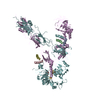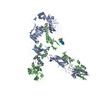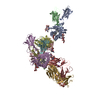+ データを開く
データを開く
- 基本情報
基本情報
| 登録情報 | データベース: PDB / ID: 7mqs | ||||||
|---|---|---|---|---|---|---|---|
| タイトル | The insulin receptor ectodomain in complex with three venom hybrid insulin molecules - asymmetric conformation | ||||||
 要素 要素 |
| ||||||
 キーワード キーワード | HORMONE / TOXIN / insulin / receptor / venom / cone snail | ||||||
| 機能・相同性 |  機能・相同性情報 機能・相同性情報negative regulation of glycogen catabolic process / positive regulation of nitric oxide mediated signal transduction / negative regulation of fatty acid metabolic process / negative regulation of feeding behavior / Signaling by Insulin receptor / IRS activation / regulation of protein secretion / Insulin processing / positive regulation of peptide hormone secretion / positive regulation of respiratory burst ...negative regulation of glycogen catabolic process / positive regulation of nitric oxide mediated signal transduction / negative regulation of fatty acid metabolic process / negative regulation of feeding behavior / Signaling by Insulin receptor / IRS activation / regulation of protein secretion / Insulin processing / positive regulation of peptide hormone secretion / positive regulation of respiratory burst / negative regulation of acute inflammatory response / Regulation of gene expression in beta cells / alpha-beta T cell activation / positive regulation of dendritic spine maintenance / Synthesis, secretion, and deacylation of Ghrelin / activation of protein kinase B activity / negative regulation of respiratory burst involved in inflammatory response / negative regulation of protein secretion / negative regulation of gluconeogenesis / positive regulation of insulin receptor signaling pathway / positive regulation of glycogen biosynthetic process / fatty acid homeostasis / Signal attenuation / FOXO-mediated transcription of oxidative stress, metabolic and neuronal genes / negative regulation of lipid catabolic process / positive regulation of lipid biosynthetic process / negative regulation of oxidative stress-induced intrinsic apoptotic signaling pathway / regulation of protein localization to plasma membrane / nitric oxide-cGMP-mediated signaling / transport vesicle / COPI-mediated anterograde transport / positive regulation of nitric-oxide synthase activity / Insulin receptor recycling / negative regulation of reactive oxygen species biosynthetic process / positive regulation of brown fat cell differentiation / insulin-like growth factor receptor binding / NPAS4 regulates expression of target genes / neuron projection maintenance / endoplasmic reticulum-Golgi intermediate compartment membrane / positive regulation of mitotic nuclear division / Insulin receptor signalling cascade / positive regulation of glycolytic process / positive regulation of cytokine production / endosome lumen / positive regulation of long-term synaptic potentiation / acute-phase response / positive regulation of protein secretion / positive regulation of D-glucose import across plasma membrane / insulin receptor binding / positive regulation of cell differentiation / Regulation of insulin secretion / wound healing / positive regulation of neuron projection development / receptor protein-tyrosine kinase / hormone activity / negative regulation of protein catabolic process / regulation of synaptic plasticity / positive regulation of protein localization to nucleus / Golgi lumen / cognition / vasodilation / glucose metabolic process / insulin receptor signaling pathway / cell-cell signaling / glucose homeostasis / regulation of protein localization / PI5P, PP2A and IER3 Regulate PI3K/AKT Signaling / positive regulation of cell growth / protease binding / secretory granule lumen / positive regulation of canonical NF-kappaB signal transduction / positive regulation of phosphatidylinositol 3-kinase/protein kinase B signal transduction / positive regulation of MAPK cascade / positive regulation of cell migration / G protein-coupled receptor signaling pathway / endoplasmic reticulum lumen / Amyloid fiber formation / Golgi membrane / negative regulation of gene expression / positive regulation of cell population proliferation / positive regulation of gene expression / regulation of DNA-templated transcription / extracellular space / extracellular region / identical protein binding 類似検索 - 分子機能 | ||||||
| 生物種 |  Homo sapiens (ヒト) Homo sapiens (ヒト) | ||||||
| 手法 | 電子顕微鏡法 / 単粒子再構成法 / クライオ電子顕微鏡法 / 解像度: 4.4 Å | ||||||
 データ登録者 データ登録者 | Blakely, A.D. / Xiong, X. / Kim, J.H. / Menting, J. / Schafer, I.B. / Schubert, H.L. / Agrawal, R. / Gutmann, T. / Delaine, C. / Zhang, Y. ...Blakely, A.D. / Xiong, X. / Kim, J.H. / Menting, J. / Schafer, I.B. / Schubert, H.L. / Agrawal, R. / Gutmann, T. / Delaine, C. / Zhang, Y. / Artik, G.O. / Merriman, A. / Eckert, D. / Lawrence, M.C. / Coskun, U. / Fisher, S.J. / Forbes, B.E. / Safavi-Hemami, H. / Hill, C.P. / Chou, D.H.C. | ||||||
| 資金援助 | 1件
| ||||||
 引用 引用 |  ジャーナル: Nat Chem Biol / 年: 2022 ジャーナル: Nat Chem Biol / 年: 2022タイトル: Symmetric and asymmetric receptor conformation continuum induced by a new insulin. 著者: Xiaochun Xiong / Alan Blakely / Jin Hwan Kim / John G Menting / Ingmar B Schäfer / Heidi L Schubert / Rahul Agrawal / Theresia Gutmann / Carlie Delaine / Yi Wolf Zhang / Gizem Olay Artik / ...著者: Xiaochun Xiong / Alan Blakely / Jin Hwan Kim / John G Menting / Ingmar B Schäfer / Heidi L Schubert / Rahul Agrawal / Theresia Gutmann / Carlie Delaine / Yi Wolf Zhang / Gizem Olay Artik / Allanah Merriman / Debbie Eckert / Michael C Lawrence / Ünal Coskun / Simon J Fisher / Briony E Forbes / Helena Safavi-Hemami / Christopher P Hill / Danny Hung-Chieh Chou /     要旨: Cone snail venoms contain a wide variety of bioactive peptides, including insulin-like molecules with distinct structural features, binding modes and biochemical properties. Here, we report an active ...Cone snail venoms contain a wide variety of bioactive peptides, including insulin-like molecules with distinct structural features, binding modes and biochemical properties. Here, we report an active humanized cone snail venom insulin with an elongated A chain and a truncated B chain, and use cryo-electron microscopy (cryo-EM) and protein engineering to elucidate its interactions with the human insulin receptor (IR) ectodomain. We reveal how an extended A chain can compensate for deletion of B-chain residues, which are essential for activity of human insulin but also compromise therapeutic utility by delaying dissolution from the site of subcutaneous injection. This finding suggests approaches to developing improved therapeutic insulins. Curiously, the receptor displays a continuum of conformations from the symmetric state to a highly asymmetric low-abundance structure that displays coordination of a single humanized venom insulin using elements from both of the previously characterized site 1 and site 2 interactions. | ||||||
| 履歴 |
|
- 構造の表示
構造の表示
| ムービー |
 ムービービューア ムービービューア |
|---|---|
| 構造ビューア | 分子:  Molmil Molmil Jmol/JSmol Jmol/JSmol |
- ダウンロードとリンク
ダウンロードとリンク
- ダウンロード
ダウンロード
| PDBx/mmCIF形式 |  7mqs.cif.gz 7mqs.cif.gz | 320.2 KB | 表示 |  PDBx/mmCIF形式 PDBx/mmCIF形式 |
|---|---|---|---|---|
| PDB形式 |  pdb7mqs.ent.gz pdb7mqs.ent.gz | 257.9 KB | 表示 |  PDB形式 PDB形式 |
| PDBx/mmJSON形式 |  7mqs.json.gz 7mqs.json.gz | ツリー表示 |  PDBx/mmJSON形式 PDBx/mmJSON形式 | |
| その他 |  その他のダウンロード その他のダウンロード |
-検証レポート
| 文書・要旨 |  7mqs_validation.pdf.gz 7mqs_validation.pdf.gz | 1.3 MB | 表示 |  wwPDB検証レポート wwPDB検証レポート |
|---|---|---|---|---|
| 文書・詳細版 |  7mqs_full_validation.pdf.gz 7mqs_full_validation.pdf.gz | 1.3 MB | 表示 | |
| XML形式データ |  7mqs_validation.xml.gz 7mqs_validation.xml.gz | 59.2 KB | 表示 | |
| CIF形式データ |  7mqs_validation.cif.gz 7mqs_validation.cif.gz | 88.5 KB | 表示 | |
| アーカイブディレクトリ |  https://data.pdbj.org/pub/pdb/validation_reports/mq/7mqs https://data.pdbj.org/pub/pdb/validation_reports/mq/7mqs ftp://data.pdbj.org/pub/pdb/validation_reports/mq/7mqs ftp://data.pdbj.org/pub/pdb/validation_reports/mq/7mqs | HTTPS FTP |
-関連構造データ
| 関連構造データ |  23951MC  7mqoC  7mqrC C: 同じ文献を引用 ( M: このデータのモデリングに利用したマップデータ |
|---|---|
| 類似構造データ | |
| 電子顕微鏡画像生データ |  EMPIAR-10736 (タイトル: Cryo-EM of the human insulin receptor ectodomain in complex with an insulin analog with truncated B chain and enlongated A chain EMPIAR-10736 (タイトル: Cryo-EM of the human insulin receptor ectodomain in complex with an insulin analog with truncated B chain and enlongated A chainData size: 11.7 TB Data #1: Unaligned multi-frame micrographs (40 e-/A2 dose) [micrographs - multiframe] Data #2: unaligned micrographs (60 e-/A2 dose) [micrographs - multiframe]) |
- リンク
リンク
- 集合体
集合体
| 登録構造単位 | 
|
|---|---|
| 1 |
|
- 要素
要素
| #1: タンパク質 | 分子量: 104632.695 Da / 分子数: 2 / 断片: Ectodomain, UNP residues 28-943 / 由来タイプ: 組換発現 / 由来: (組換発現)  Homo sapiens (ヒト) / 遺伝子: INSR / 発現宿主: Homo sapiens (ヒト) / 遺伝子: INSR / 発現宿主:  Homo sapiens (ヒト) / 参照: UniProt: P06213-2, receptor protein-tyrosine kinase Homo sapiens (ヒト) / 参照: UniProt: P06213-2, receptor protein-tyrosine kinase#2: タンパク質・ペプチド | 分子量: 2736.106 Da / 分子数: 3 / Mutation: N21H / 由来タイプ: 合成 / 由来: (合成)  Homo sapiens (ヒト) / 参照: UniProt: P01308 Homo sapiens (ヒト) / 参照: UniProt: P01308#3: タンパク質・ペプチド | 分子量: 2537.951 Da / 分子数: 3 / Mutation: H10E, G20L / 由来タイプ: 合成 / 由来: (合成)  Homo sapiens (ヒト) / 参照: UniProt: P01308 Homo sapiens (ヒト) / 参照: UniProt: P01308Has protein modification | Y | 配列の詳細 | Elongated Insulin chain A was modified to contain three additional C-terminal residues (SQL) | |
|---|
-実験情報
-実験
| 実験 | 手法: 電子顕微鏡法 |
|---|---|
| EM実験 | 試料の集合状態: PARTICLE / 3次元再構成法: 単粒子再構成法 |
- 試料調製
試料調製
| 構成要素 | 名称: Insulin receptor ectodomain in complex with insulin analog Vh-Ins-HSLQ - asymmetric conformation. タイプ: COMPLEX / Entity ID: all / 由来: MULTIPLE SOURCES | |||||||||
|---|---|---|---|---|---|---|---|---|---|---|
| 分子量 | 値: 0.209 MDa / 実験値: NO | |||||||||
| 由来(天然) | 生物種:  Homo sapiens (ヒト) Homo sapiens (ヒト) | |||||||||
| 由来(組換発現) | 生物種:  Homo sapiens (ヒト) Homo sapiens (ヒト) | |||||||||
| 緩衝液 | pH: 8 詳細: Equal parts HBS(50 mM HEPES pH 7.5, 150 mM NaCl ) and TBS (25 mM Tris pH 8.5, 150 mM NaCl) | |||||||||
| 緩衝液成分 |
| |||||||||
| 試料 | 包埋: NO / シャドウイング: NO / 染色: NO / 凍結: YES | |||||||||
| 試料支持 | グリッドのタイプ: Quantifoil R1.2/1.3 | |||||||||
| 急速凍結 | 装置: FEI VITROBOT MARK II / 凍結剤: ETHANE / 湿度: 80 % / 凍結前の試料温度: 277 K |
- 電子顕微鏡撮影
電子顕微鏡撮影
| 実験機器 |  モデル: Titan Krios / 画像提供: FEI Company |
|---|---|
| 顕微鏡 | モデル: FEI TITAN KRIOS |
| 電子銃 | 電子線源:  FIELD EMISSION GUN / 加速電圧: 300 kV / 照射モード: FLOOD BEAM FIELD EMISSION GUN / 加速電圧: 300 kV / 照射モード: FLOOD BEAM |
| 電子レンズ | モード: BRIGHT FIELD |
| 撮影 | 電子線照射量: 40 e/Å2 / 検出モード: COUNTING フィルム・検出器のモデル: GATAN K2 SUMMIT (4k x 4k) |
- 解析
解析
| ソフトウェア | 名称: PHENIX / バージョン: 1.19.1_4122: / 分類: 精密化 | |||||||||||||||||||||||||||||||||||
|---|---|---|---|---|---|---|---|---|---|---|---|---|---|---|---|---|---|---|---|---|---|---|---|---|---|---|---|---|---|---|---|---|---|---|---|---|
| EMソフトウェア |
| |||||||||||||||||||||||||||||||||||
| CTF補正 | タイプ: PHASE FLIPPING AND AMPLITUDE CORRECTION | |||||||||||||||||||||||||||||||||||
| 3次元再構成 | 解像度: 4.4 Å / 解像度の算出法: FSC 0.143 CUT-OFF / 粒子像の数: 43457 / 対称性のタイプ: POINT | |||||||||||||||||||||||||||||||||||
| 精密化 | 交差検証法: NONE 立体化学のターゲット値: GeoStd + Monomer Library + CDL v1.2 | |||||||||||||||||||||||||||||||||||
| 原子変位パラメータ | Biso mean: 200.72 Å2 | |||||||||||||||||||||||||||||||||||
| 拘束条件 |
|
 ムービー
ムービー コントローラー
コントローラー












 PDBj
PDBj

















